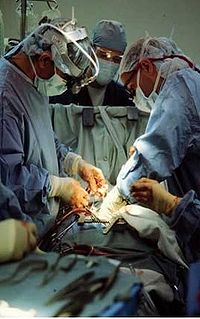
Photo from wikipedia
Background Although tricuspid valve surgery improves functional capacity in patients with Ebstein anomaly, it is not always associated with improvement in aerobic capacity. The purpose of this study was to… Click to show full abstract
Background Although tricuspid valve surgery improves functional capacity in patients with Ebstein anomaly, it is not always associated with improvement in aerobic capacity. The purpose of this study was to identify the determinants of improved aerobic capacity after tricuspid valve surgery in adults with Ebstein anomaly with severe tricuspid regurgitation. Methods Retrospective study of patients with severe tricuspid regurgitation due to Ebstein anomaly that had tricuspid valve surgery at Mayo Clinic Rochester (2000–2019) and had preoperative and postoperative cardiopulmonary exercise tests and echocardiograms. The patients were divided into aerobic capacity(+) and aerobic capacity(-) groups depending on whether they had postoperative improvement in %-predicted peak oxygen consumption (VO2). Results Of 76 patients with severe tricuspid regurgitation due to Ebstein anomaly, 28 (37%) and 48 (63%) were in aerobic capacity(+) and aerobic capacity(-) groups, respectively. The average improvement in peak VO2 was 2.1±1.4 mL/kg/min and −0.9±0.4 mL/kg/min in the in aerobic capacity(+) and aerobic capacity(-) groups, respectively. Although both groups had similar severity of residual tricuspid regurgitation, the aerobic capacity(+) group had more postoperative improvement in right atrial (RA) function, left atrial (LA) function and left ventricular preload and stroke volume. Of the preoperative variables analysed, RA reservoir strain (relative risk 1.12; 95% CI 1.06 to 1.18); LA reservoir strain (relative risk 1.09; 95% CI 1.04 to 1.14) and LV stroke volume index (OR 1.04; 95% CI 1.01 to 1.07) were predictors of postoperative improvement in peak VO2. Conclusions One-third of patients with severe tricuspid regurgitation due to Ebstein anomaly had postoperative improvement in aerobic capacity, and atrial function indices were the best predictors of postoperative improvement in aerobic capacity. These data provide new insight into the haemodynamic determinants of exercise capacity and lay the foundation for further studies to determine whether postoperative improvement in aerobic capacity translates to improved long-term survival, and whether timing of tricuspid valve surgery based on these echocardiographic indices will improve long-term outcomes.
Journal Title: Heart
Year Published: 2020
Link to full text (if available)
Share on Social Media: Sign Up to like & get
recommendations!